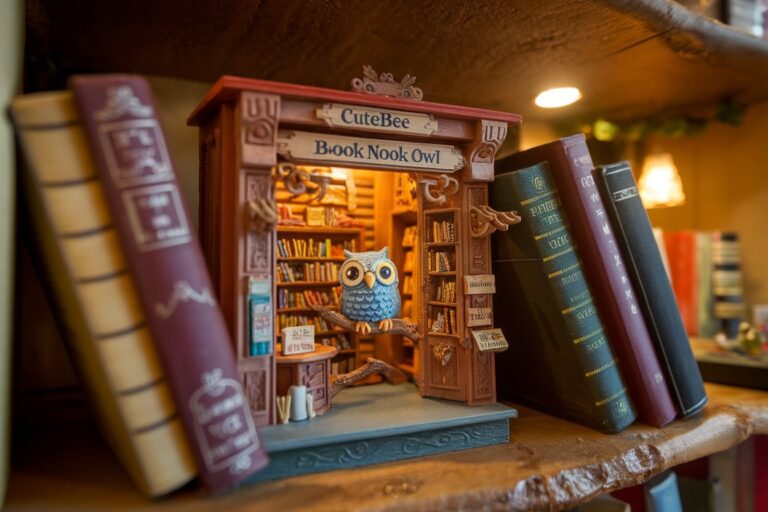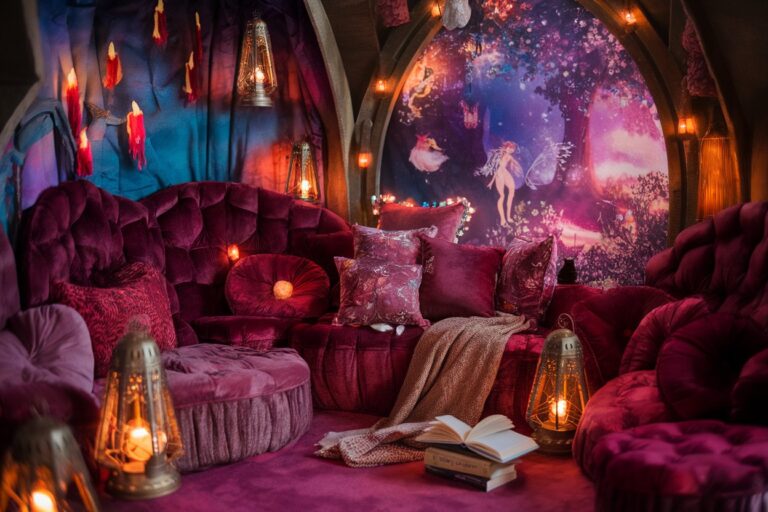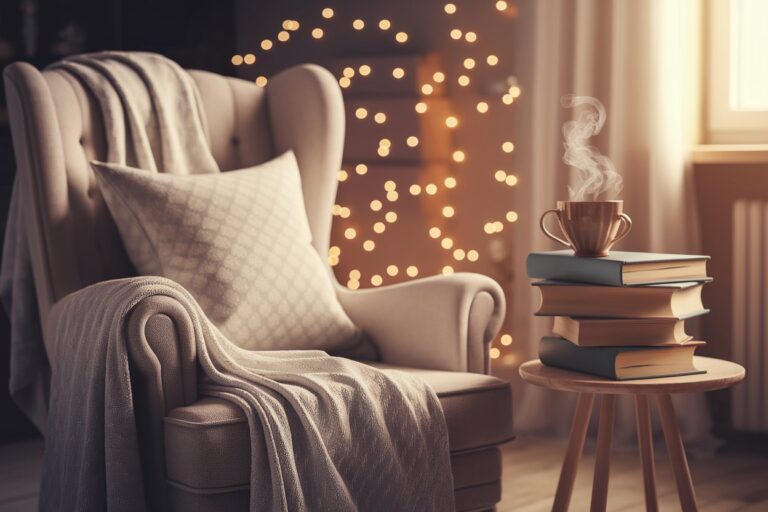Discover 15 cozy reading nook ideas perfect for any space or budget. Create your dream book lover’s retreat with these expert tips and inspiration.
There’s something magical about having your own little corner where the outside world fades away, and it’s just you and your favorite book. Whether you’re a casual reader who enjoys the occasional bestseller or someone who devours novels like their air, a dedicated reading nook can transform both your space and your reading experience.
I’ve always believed that the perfect reading spot is more than just a chair with good lighting—it’s a sanctuary that reflects your personality while providing the comfort you need to lose yourself in stories for hours. Having created several reading nooks in my own homes over the years (some successful, others… learning experiences), I’m excited to share ideas that work for spaces of all sizes and budgets.
In this guide, we’ll explore 15 creative reading nook ideas that combine comfort, style, and practicality. From window seats bathed in natural light to repurposed closets transformed into cozy hideaways, these ideas will inspire you to carve out your own literary retreat, no matter how limited your space might be.
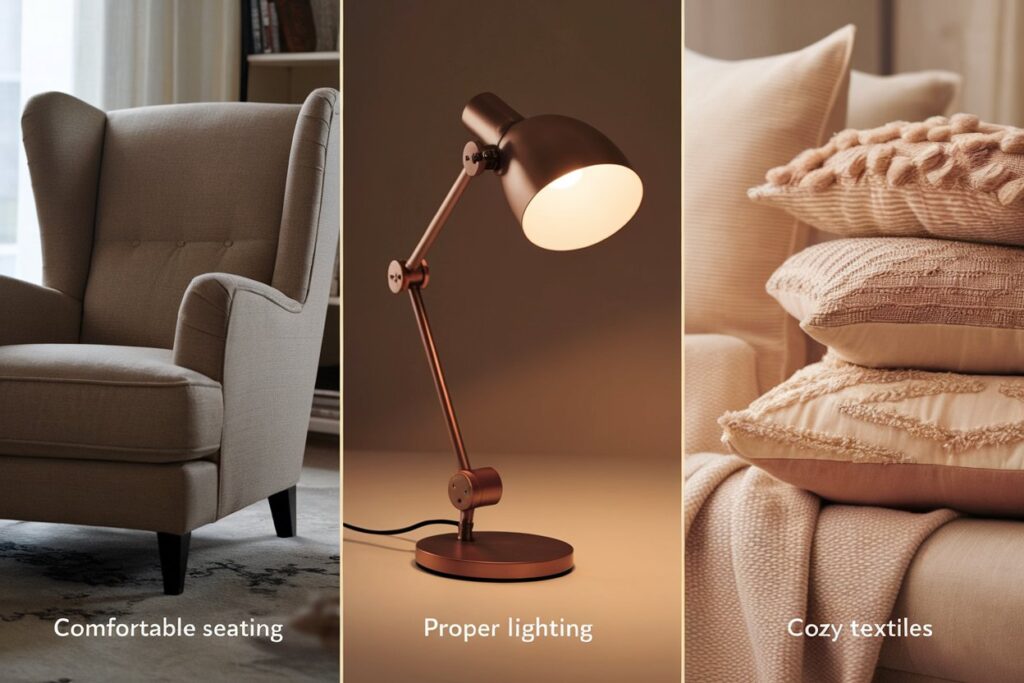
Table of Contents
- What Makes a Perfect Reading Nook?
- 1. Window Seat Wonders: Embrace Natural Light
- 2. Corner Retreat: Making the Most of Awkward Spaces
- 3. Closet Conversion: The Ultimate Reading Hideaway
- 4. Under-Stair Sanctuary: Utilizing Overlooked Space
- 5. Bedroom Reading Corner: Your Pre-Sleep Retreat
- 6. Dual-Purpose Daybeds: Reading and Guest Accommodations
- 7. Living Room Reading Zone: Creating Distinction in Open Spaces
- 8. Kid-Friendly Reading Nooks: Nurturing Young Readers
- 9. Outdoor Reading Retreats: Connecting with Nature
- 10. Tech-Friendly Reading Corners: Embracing Modern Reading Habits
- 11. Bay Window Bliss: Maximizing Architectural Features
- 12. Forgotten Spaces: Hallway & Landing Reading Nooks
- 13. Multi-Purpose Room Reading Areas: Carving Out Literary Space
- 14. Themed Reading Retreats: Celebrating Literary Passions
- 15. Minimalist Reading Corners: Finding Peace in Simplicity
- Frequently Asked Questions About Reading Nooks
- Creating Your Perfect Reading Nook: From Inspiration to Reality
- Conclusion: Your Reading Sanctuary Awaits
What Makes a Perfect Reading Nook?
Before diving into specific ideas, let’s talk about what transforms an ordinary corner into a reading paradise.
The Essential Elements of a Great Reading Nook
A truly inviting reading nook combines three fundamental elements:
- Comfortable seating that supports your body during long reading sessions
- Proper lighting that’s adjustable and prevents eye strain
- Cozy textiles that add warmth and tactile comfort
Beyond these basics, the best reading nooks also incorporate:
- Accessible book storage that keeps favorites within arm’s reach
- Personal touches that reflect your unique style and interests
- A sense of enclosure that creates a psychological boundary from the rest of your home
With these principles in mind, let’s explore 15 inspiring reading nook ideas that you can adapt to your own space.

1. Window Seat Wonders: Embrace Natural Light
There’s a reason window seats have been reading nook favorites for centuries. Positioned to capture natural light, they create a perfect marriage between indoor comfort and connection to the outdoors.
Why It Works:
Window seats maximize natural light, which is ideal for daytime reading. The view outside provides a pleasant backdrop when you look up from your book, giving your eyes a moment to rest while connecting you with nature or your neighborhood.
How to Create It:
If you’re lucky enough to have a deep windowsill, adding a cushion might be all you need. For a more permanent solution, consider:
- Building a simple bench that fits the window’s width
- Adding hinged storage beneath the seat for books or extra blankets
- Installing floating shelves on adjacent walls for vertical storage
- Topping with a custom cushion in a durable, washable fabric
- Layering with pillows that complement your room’s color scheme
Budget-Friendly Tip:
Instead of custom carpentry, repurpose a low bookshelf laid horizontally beneath your window, topped with a foam cushion covered in fabric you love.
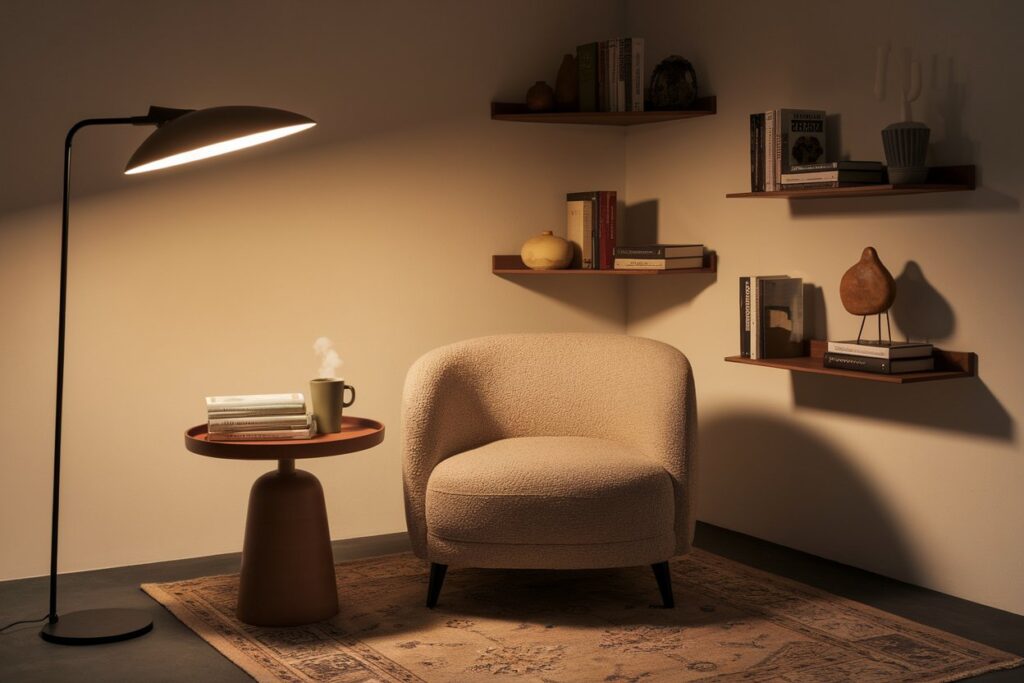
2. Corner Retreat: Making the Most of Awkward Spaces
Those awkward corners in your home? They’re actually perfect candidates for intimate reading nooks that don’t require much square footage.
Why It Works:
Corners naturally create a sense of enclosure on two sides, making them perfect for establishing a distinct “zone” in open-concept homes. They’re also often underutilized, turning wasted space into one of your home’s most treasured spots.
How to Create It:
- Position a comfortable chair or small loveseat at a 45-degree angle in the corner
- Add a floor lamp behind or beside the seating
- Include a small side table for books and beverages
- Consider a small area rug to further define the space
- Install corner shelving above for book storage that doesn’t take up floor space
Perfect For:
This solution works beautifully in bedrooms, living rooms, or even home office corners where you want to take reading breaks.
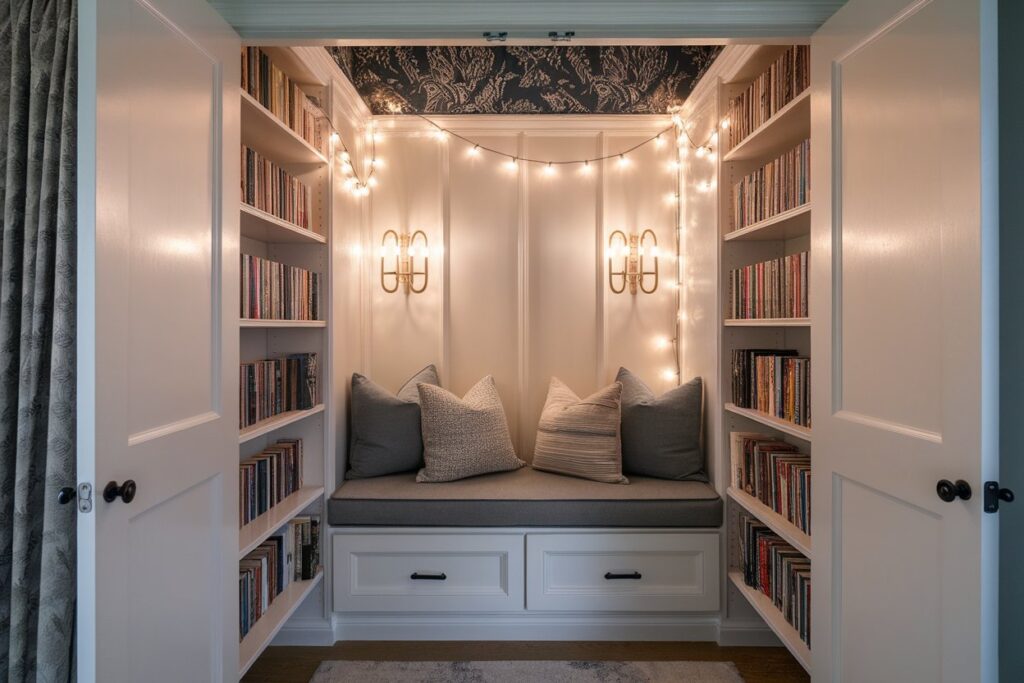
3. Closet Conversion: The Ultimate Reading Hideaway
If you have an underused closet or a small nook built into a wall, you might be sitting on reading nook gold. These spaces can be transformed into the most intimate and enveloping reading retreats.
Why It Works:
The enclosed nature of a closet creates an instant sense of sanctuary. The smaller dimensions actually work in your favor, creating a cocoon-like environment that encourages focus and immersion in your book.
How to Create It:
- Remove the closet door or replace it with a curtain for a softer look
- Install a bench seat or add a child-sized armchair for tighter spaces
- Line the walls with shelving for books
- Add battery-operated puck lights or string lights if electrical outlets aren’t available
- Use wallpaper or a bold paint color to designate this as a special space
- Add plush pillows and a small throw blanket for comfort
Reader’s Experience:
“I converted my guest room’s shallow closet into a reading nook, and it’s become everyone’s favorite spot when they visit. There’s something about being surrounded by books in a small space that feels like a hug.”
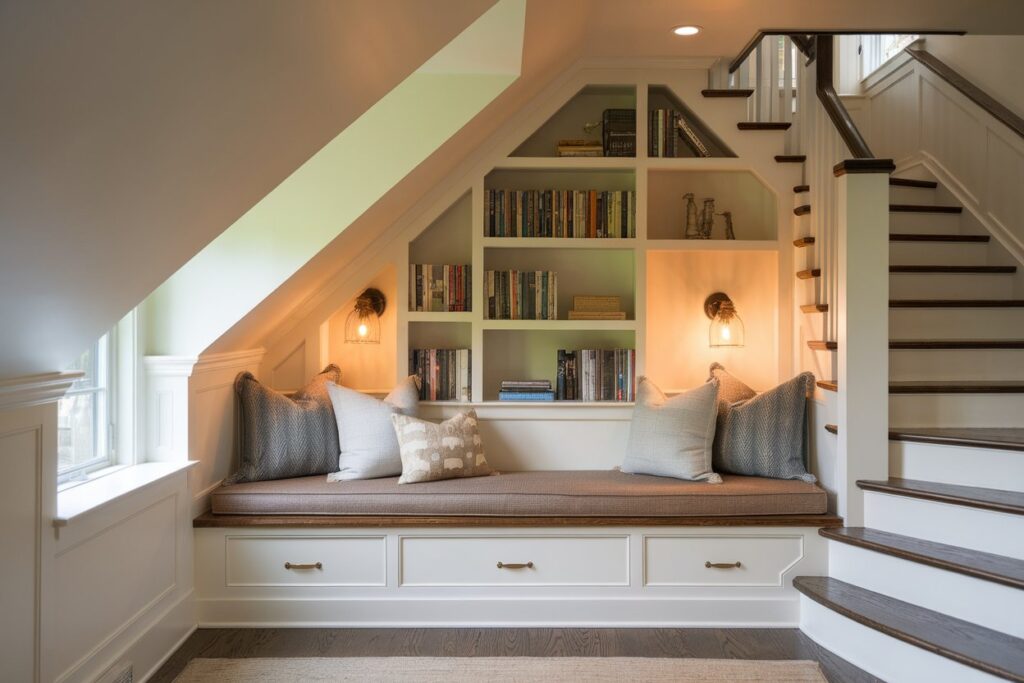
4. Under-Stair Sanctuary: Utilizing Overlooked Space
The space beneath a staircase is often relegated to storage or simply walled off. But with some creativity, this architectural oddity can become one of the most charming reading nooks in your home.
Why It Works:
The sloped ceiling creates a naturally cozy feeling, and the unusual shape makes for a distinctive space that feels separate from the rest of your home. It’s also typically in a central location but removed from the main traffic flow.
How to Create It:
- Measure the available space carefully, accounting for the slope
- Consider built-in bench seating that maximizes the available width
- Add cushions that can accommodate the changing height
- Install recessed lighting or wall sconces to avoid head clearance issues
- Use the walls for built-in shelving or magazine racks
- If space allows, include a small drawer or cabinet for reading accessories
Designer Tip:
“When designing under-stair reading nooks, I like to use the same wood tone as the stairs themselves for built-ins. This creates visual continuity and makes the nook feel like an intentional part of the home’s architecture rather than an afterthought.”
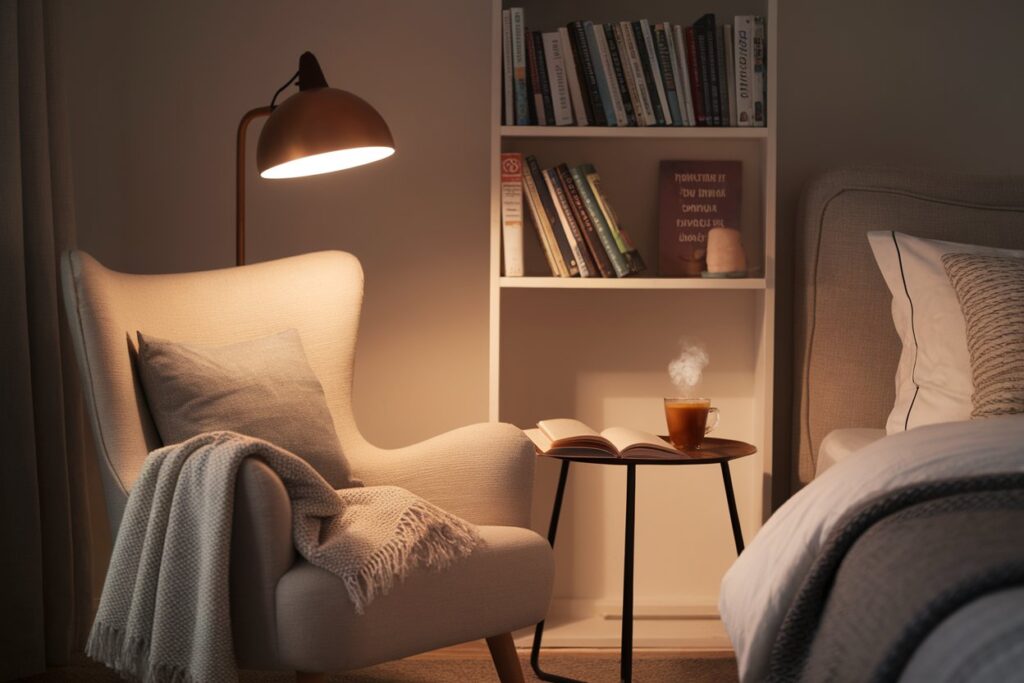
5. Bedroom Reading Corner: Your Pre-Sleep Retreat
While many reading nooks exist in common areas, creating one in your bedroom can enhance both your reading routine and your sleep quality.
Why It Works:
Reading before bed is a proven way to improve sleep quality and reduce stress. Having a dedicated spot that’s not your bed helps maintain healthy sleep associations while giving you a comfortable place to unwind with a book.
How to Create It:
- Choose a corner away from your bed but still with good access to lighting
- Select a comfortable chair that supports good posture
- Include a small side table for books and perhaps a cup of tea
- Add a reading lamp with warm light that won’t interfere with melatonin production
- Consider a small bookshelf or floating shelves for current reads
- Include a soft throw blanket for cooler evenings
Perfect For:
This setup is ideal for those who love bedtime reading but want to maintain their bed as a sleep-only zone for better sleep hygiene.
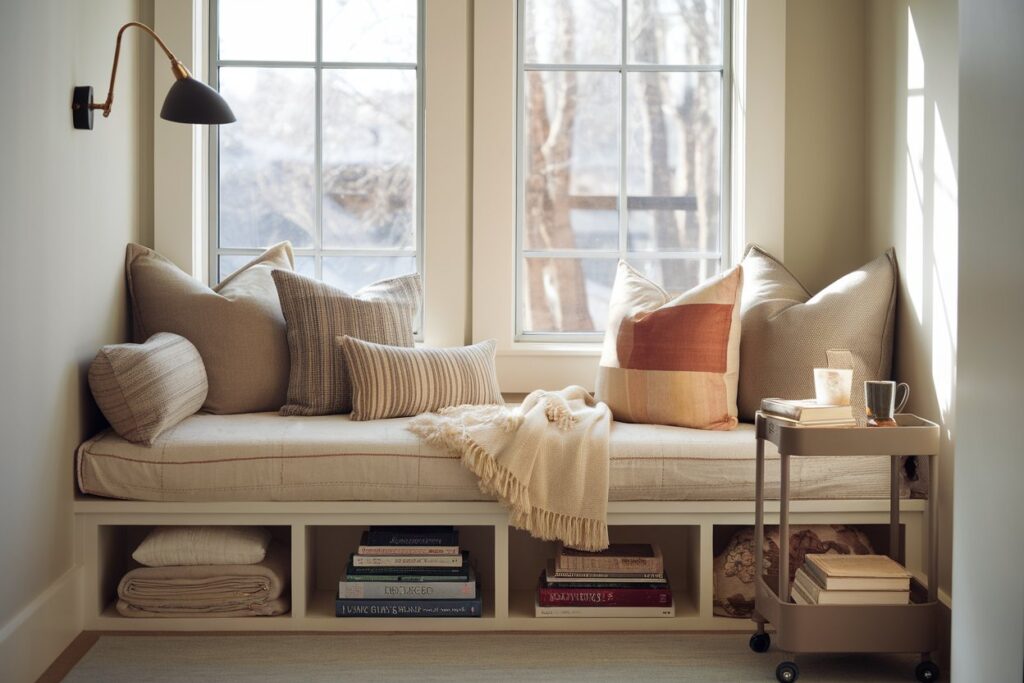
6. Dual-Purpose Daybeds: Reading and Guest Accommodations
For homes where space is at a premium, furniture that serves multiple functions is invaluable. A daybed can be both a comfortable reading spot and occasional guest accommodation.
Why It Works:
Daybeds offer the depth needed to sit comfortably with your legs up while reading. When positioned against a wall and dressed with pillows, they function much like a sofa during the day, while providing sleeping space for visitors when needed.
How to Create It:
- Position a daybed against a wall, ideally near a window
- Add a variety of firm pillows to support different reading positions
- Include wall-mounted lighting that works for both reading and ambient light
- Surround with low bookshelves or include storage drawers underneath
- Add a small side table or rolling cart for books and beverages
- Choose bedding that works visually as both a sofa cover and guest bedding
Styling Tip:
Use pillows in varying sizes—some for lumbar support, others for armrests, and larger ones for when you want to lean against the wall while reading. This flexibility allows you to adjust your position during longer reading sessions.
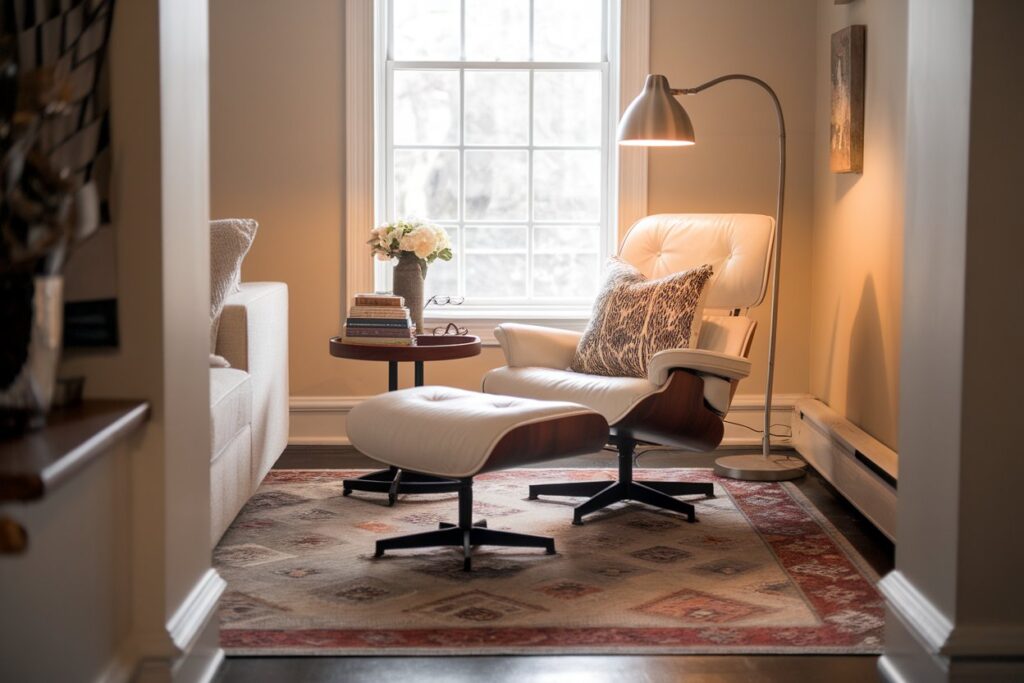
7. Living Room Reading Zone: Creating Distinction in Open Spaces
Not every reading nook needs to be tucked away. Creating a designated reading zone within your living room can add functionality while maintaining the open flow.
Why It Works:
This approach allows you to participate in family life while still having a space that’s recognized as your reading territory. It’s particularly suitable for parents who need to keep an eye on children while enjoying some reading time.
How to Create It:
- Position a comfortable armchair at a slight angle from the main seating arrangement
- Define the space with a small area rug in a complementary but distinct pattern
- Add a floor lamp positioned specifically for reading
- Include a side table dedicated to books and reading accessories
- Consider a small ottoman that can serve as both footrest and extra seating
- Use a different but harmonious color palette to visually separate the space
Design Challenge:
“The key to creating distinct zones in open spaces is to use visual cues that signal a change in function without erecting physical barriers. A reading lamp and chair in a slightly different style than your main living room furniture can create that separation while maintaining flow.”

8. Kid-Friendly Reading Nooks: Nurturing Young Readers
Creating reading spaces specifically designed for children can foster a lifelong love of books while giving them a sense of ownership over their reading journey.
Why It Works:
Children are naturally drawn to special, scaled-down spaces that feel made just for them. A dedicated reading nook signals that reading is both important and fun, while child-appropriate design encourages them to spend time there.
How to Create It:
- Use lower seating appropriate for smaller bodies (floor cushions, bean bags, or child-sized chairs)
- Install front-facing bookshelves that display covers rather than spines
- Consider adding a canopy, tent, or other structure that creates a sense of magic
- Include soft lighting that creates an ambiance without shadows
- Add themed elements based on favorite books (Narnia wardrobe, Harry Potter under-stairs nook)
- Rotate books periodically to maintain interest and highlight seasonal reads
Educational Benefit:
“Creating a special place just for reading helps children associate books with pleasure rather than obligation. When my son’s teacher suggested creating a reading nook at home, we turned a corner of his room into a ‘book cave’ with a small tent and string lights. His voluntary reading time has doubled.”
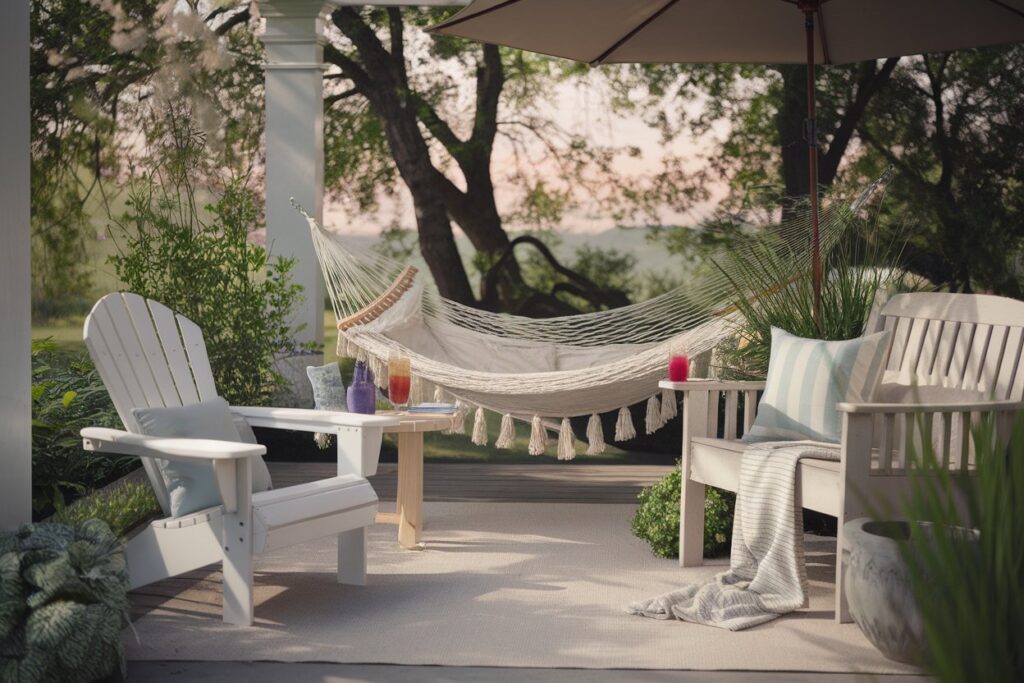
9. Outdoor Reading Retreats: Connecting with Nature
Reading doesn’t have to be confined to indoor spaces. Creating a seasonal or year-round outdoor reading retreat connects literature with nature in a refreshing way.
Why It Works:
Research shows that spending time in natural settings reduces stress and improves concentration—both conducive to deep reading. The changing light and gentle background sounds can enhance the reading experience.
How to Create It:
- Choose weather-appropriate, comfortable seating (Adirondack chairs, porch swings, hammocks)
- Ensure adequate shade for eye comfort and device protection
- Consider a small, weatherproof cabinet for storing books during your reading session
- Add outdoor pillows and throws for cooler days
- Include a small side table for drinks and snacks
- Create wind protection for pages with decorative screens or strategic plantings
Seasonal Considerations:
In temperate climates, embrace seasonal changes by adding heating elements like fire pits or patio heaters for fall reading, or misters and fans for summer comfort.

10. Tech-Friendly Reading Corners: Embracing Modern Reading Habits
While traditional book reading remains popular, many readers now toggle between physical books, e-readers, and audiobooks. A tech-friendly reading nook acknowledges these modern habits.
Why It Works:
Accommodating various reading formats makes your nook more versatile and likely to be used regularly. It also acknowledges that different reading formats serve different purposes and situations.
How to Create It:
- Ensure access to electrical outlets for charging devices
- Include a tablet or e-reader stand for hands-free reading
- Consider a small Bluetooth speaker for audiobook listening
- Add noise-canceling headphones for shared spaces
- Choose a chair with good arm support for holding devices
- Include a dedicated drawer or container for cords and accessories
Tech Tip:
“I installed a small shelf next to my reading chair with a wireless charging pad built into the surface. My devices stay charged without the visual clutter of cords, and I’m never caught with a dead battery mid-chapter.”

11. Bay Window Bliss: Maximizing Architectural Features
Bay windows create natural alcoves that practically beg to be transformed into reading nooks. Their depth and abundant light make them ideal candidates for reader’s retreats.
Why It Works:
Bay windows offer panoramic views and excellent natural lighting, along with a sense of being slightly removed from the main room while still remaining connected.
How to Create It:
- Build a cushioned bench that follows the window’s contours
- Add storage beneath with drawers or cabinets
- Install floating shelves or small bookcases on adjacent walls
- Layer with cushions that can be arranged for various sitting positions
- Add curtains that can be drawn for privacy or to reduce glare
- Include a small table that can accommodate a beverage or reading light
Design Consideration:
Consider the orientation of your bay window when planning your nook. South-facing windows provide consistent light but might need shades for glare control, while north-facing windows offer gentle, even lighting ideal for reading.
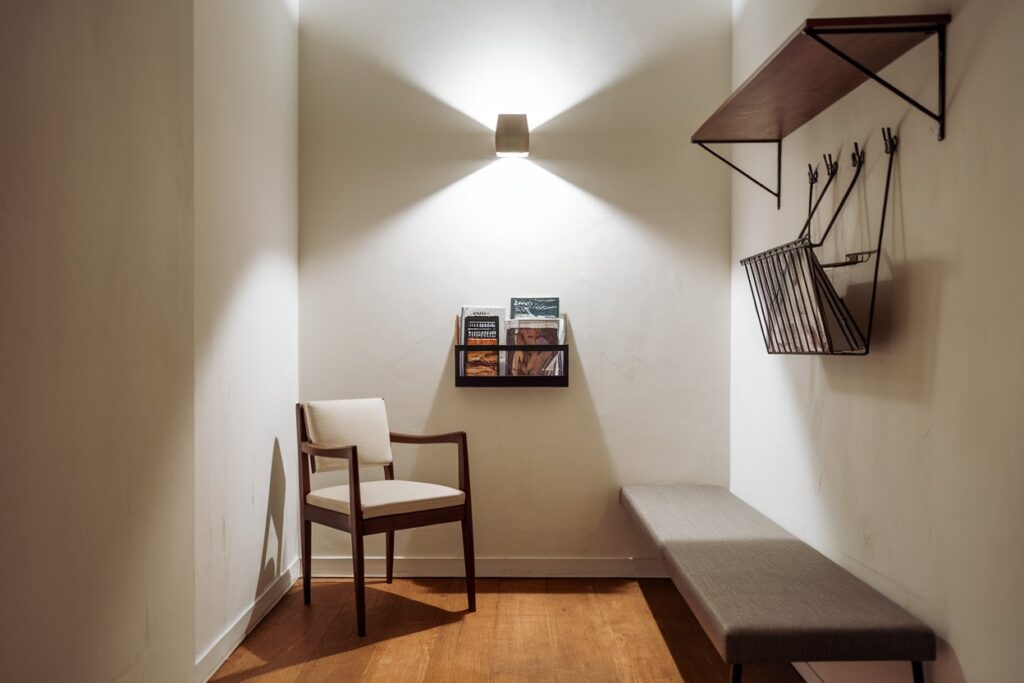
12. Forgotten Spaces: Hallway & Landing Reading Nooks
Hallways, landings, and other transitional spaces often contain small alcoves or wider areas that can be transformed into charming reading nooks that don’t intrude on room functions.
Why It Works:
These overlooked spaces already exist outside the flow of your main living areas, making them perfect for quiet moments with a book. Their “in-between” nature also makes them ideal transition zones between busy activities and quieter pursuits.
How to Create It:
- Look for wider sections of hallways or stair landings with natural stopping points
- Add a narrow bench or small chair that doesn’t impede traffic flow
- Install wall sconces or picture lights that don’t take up floor or surface space
- Use vertical space for bookshelves or magazine racks
- Consider a wall-mounted desk that can fold down for reading and note-taking
- Keep decor minimal but intentional to avoid creating a cluttered feeling
Unexpected Benefit:
“The reading nook we created on our upstairs landing has become a natural buffer zone between work and home life. I stop there for 10 minutes with a book when I come home, and it helps me transition mentally from professional to parent mode.”
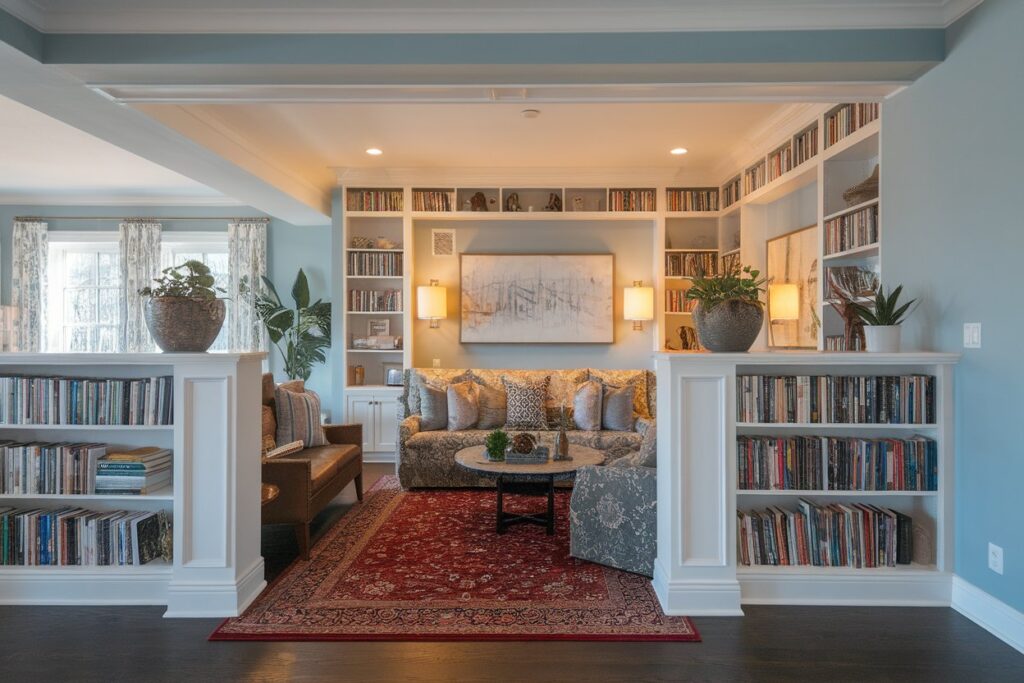
13. Multi-Purpose Room Reading Areas: Carving Out Literary Space
Not everyone has the luxury of dedicated spaces for single activities. Creating a reading area within a multi-function room requires thoughtful design to maintain separation while acknowledging shared use.
Why It Works:
By using visual and psychological boundaries, you can create the feeling of a separate reading space even in rooms that serve multiple purposes. This approach is particularly valuable in apartments, small homes, or rooms that need to accommodate various activities.
How to Create It:
- Use furniture arrangement to create a visual boundary (the back of a sofa, a bookshelf turned perpendicular to the wall)
- Add a screen, curtain, or open shelving unit as a room divider
- Define the area with a distinct area rug
- Choose a different lighting scheme for the reading zone
- Consider a color palette that complements but differs from the main room
- Use plants or tall decorative objects to create a sense of enclosure
Designer Insight:
“The key to successful multi-purpose spaces is creating distinct zones without making the room feel chopped up. I like using open bookcases as room dividers—they provide storage for books on the reading side while displaying decorative objects on the other side, maintaining visual flow while defining separate areas.”
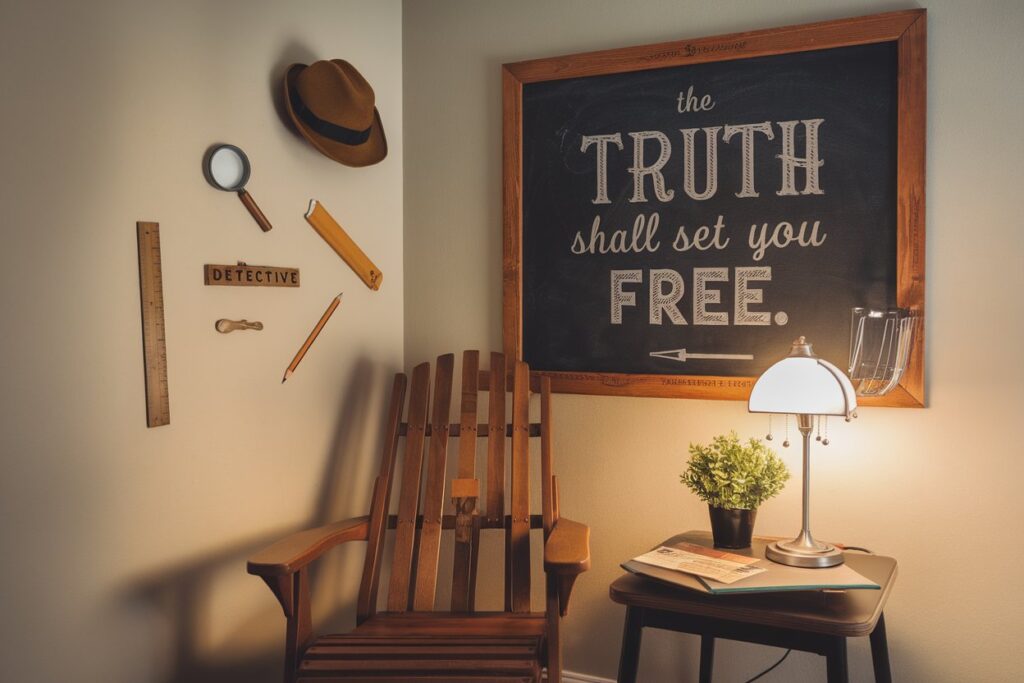
14. Themed Reading Retreats: Celebrating Literary Passions
For dedicated readers with specific literary passions, a themed reading nook can celebrate favorite genres, authors, or literary worlds.
Why It Works:
A themed space creates an immersive environment that enhances your connection to beloved books. It also makes your reading nook a true reflection of your personality and passions.
How to Create It:
- Choose elements that evoke your favorite literary world (vintage globes for adventure novels, celestial motifs for sci-fi)
- Incorporate quotes from beloved books as wall art or custom pillows
- Select a color palette inspired by iconic book covers or settings
- Add subtle themed accessories that won’t overwhelm the space
- Include appropriate lighting (industrial for steampunk, warm amber for historical fiction)
- Consider themed bookends or storage solutions that complement your concept
Personal Example:
“As a mystery lover, I created a reading nook inspired by classic detective novels. A vintage leather chair, a magnifying glass on the side table, and framed vintage Agatha Christie cover create an atmosphere that enhances my reading experience without looking like a theme park.”

15. Minimalist Reading Corners: Finding Peace in Simplicity
In contrast to more elaborate setups, a minimalist reading corner focuses on the essentials, creating a distraction-free environment where the book becomes the center of attention.
Why It Works:
For many readers, visual clutter can be mentally distracting. A minimalist approach reduces stimuli, allowing for a deeper focus on reading while creating a calming environment that promotes relaxation.
How to Create It:
- Choose a single, high-quality piece of seating with excellent support
- Select one perfect reading light with adjustable brightness
- Limit visible book storage to current reads only
- Use a neutral color palette with perhaps one accent color
- Include just one carefully chosen decorative element
- Keep the floor and surrounding surfaces clear of unnecessary items
Reader Reflection:
“After trying various elaborate reading nook setups, I discovered I read most deeply in my simplest space—just an excellent chair, perfect light, and a small table for my tea. Without visual distractions, I fall into books more completely.”
Frequently Asked Questions About Reading Nooks
How do I choose the perfect location for my reading nook?
When selecting a location, consider both practical and atmospheric factors. Look for areas with good natural light during the hours you typically read, some distance from noisy household centers like kitchens, and proximity to features that enhance relaxation like fireplaces or views of nature. Consider underutilized spaces such as landings, wall nooks, or unused corners that could be transformed with minimal effort.
What seating options work best for small spaces?
Small spaces require creative seating solutions. Consider wall-mounted benches that don’t protrude far into the room, floor cushions that can be stored when not in use, or compact armchairs with smaller profiles. Window seats are perfect for small spaces as they utilize existing architectural features without consuming additional floor space. Look for furniture with built-in storage to maximize functionality.
How important is lighting in a reading nook?
Lighting is crucial for both practical reading comfort and atmosphere. Eye strain from poor lighting can quickly turn reading from pleasure to pain. Ideally, layer different lighting types: natural light supplemented by a direct reading light that can be adjusted as daylight changes, plus ambient lighting for evening ambiance. Position lights to illuminate pages without creating glare or shadows, and consider the color temperature—warmer lights are typically more relaxing for leisure reading.
Can I create a reading nook in a multi-purpose room?
Absolutely! Use visual cues to define your reading area within larger spaces. Area rugs, different lighting fixtures, or furniture arranged to create a sense of enclosure can all designate a reading zone. Room dividers, bookcases, or even strategically placed plants can create psychological boundaries without physical walls. The key is creating a visual distinction that signals “this space is for reading” even within a room that serves other functions.
What colors promote relaxation in a reading nook?
Colors significantly impact mood and concentration. For maximum relaxation, consider cool tones like soft blues, gentle greens, or lavender, which research suggests can lower blood pressure and heart rate. Warm neutrals like taupe or soft cream create a cozy feeling without distraction. For concentration, muted tones often work better than bold colors, though a single accent color can add energy without overwhelming the space.
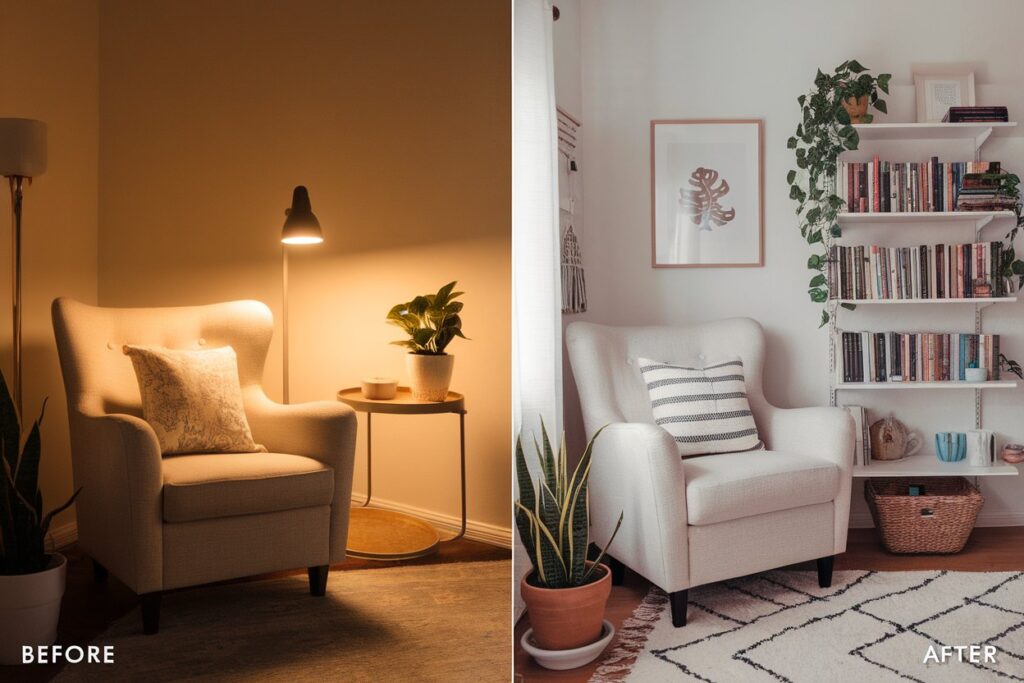
Creating Your Perfect Reading Nook: From Inspiration to Reality
Now that we’ve explored various reading nook ideas, you might be wondering how to get started creating your own. Here’s a simple process to move from inspiration to implementation:
1. Assess Your Space and Reading Habits
Start by considering:
- When and how do you typically read (morning light reader or evening with a reading lamp?)
- Available spaces in your home that could accommodate a nook
- Your budget and DIY comfort level
- Must-have features versus nice-to-haves
2. Create a Simple Plan
Sketch your ideas, take measurements, and make a list of needed items. Consider starting with these essentials:
| Essential Component | Budget Option | Mid-Range Option | Luxury Option |
|---|---|---|---|
| Seating | Floor cushions ($20-40) | Papasan chair ($100-200) | Ergonomic armchair ($300+) |
| Lighting | Clip-on book light ($15-25) | Adjustable floor lamp ($50-100) | Designer reading lamp ($150+) |
| Comfort Additions | Throw blanket ($20-30) | Plush pillows and throw ($75-100) | Custom cushions and premium textiles ($200+) |
| Book Storage | Wall-mounted shelves ($30-50) | Floating bookshelves ($80-120) | Built-in bookcases ($300+) |
3. Start Small and Evolve
Your reading nook doesn’t need to be perfect immediately. Begin with the essentials:
- A comfortable place to sit
- Good lighting
- A surface for your book and perhaps a beverage
Over time, you can add elements that enhance both functionality and atmosphere:
- Better storage solutions
- More luxurious textiles
- Decorative elements that reflect your personality
4. Make It Personally Meaningful
The most successful reading nooks go beyond functionality to create an emotional connection. Consider incorporating:
- Mementos that inspire you
- Photos or art that bring you joy
- Elements of nature like small plants
- Scents that enhance concentration or relaxation
Conclusion: Your Reading Sanctuary Awaits
Creating a reading nook is about more than just finding a place to sit with a book—it’s about carving out a sanctuary for your imagination in a world full of distractions. Whether you transform an unused closet, claim a sunny window seat, or rearrange a corner of your living room, the perfect reading nook is one that calls to you, inviting you to slow down and fall into a story.
The most beautiful aspect of reading nooks is their intensely personal nature. While interior design magazines might showcase elaborate custom builds, the truth is that the most successful reading spaces are those that reflect their owners’ unique needs and personalities. Your perfect nook might be minimalist and serene or bursting with color and mementos—what matters is that it feels like a space made just for you and your books.
I hope these ideas have inspired you to create or improve your own reading retreat. Remember that like a good book, the best reading nooks evolve over time, collecting new elements that enhance your experience page by page. The journey of creating your perfect reading space is as personal and rewarding as the reading itself.
What will your reading nook story be?

